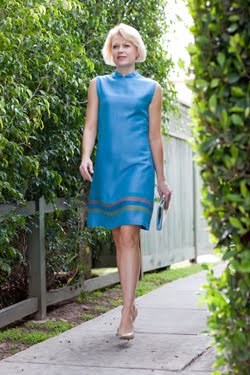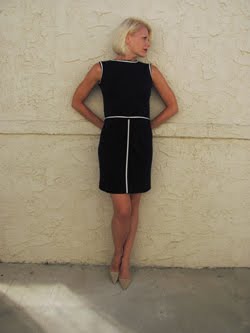Roman Polanski's 1974 masterpiece Chinatown will be shown at this year's TCM Classic Film Festival--Style in the Movies--as part of the 100th anniversary of Paramount Studios and Robert Evans' Paramount Renaissance. I consider Chinatown one of the ten best movies of all time, so I am absolutely thrilled it will soon be on the big screen once again. I don't think I'm overstating it when I say this is a perfect film...that adjective seems apropos when considering all the people and parts that make up Polanski's picture. As most know, it all started with its legendary script...along with Polanski, screenwriter Robert Towne crafted a neo-noir as good as the novels of Chandler, Hammett, and Cain. His brilliance was giving his fiction a factual basis--the California Water Wars--and finding mystery in the power struggles of early Los Angeles that could mask and then reveal his characters' psychological dramas. In fact, Chinatown is Towne's own metaphor for the often futile struggle for power and the shades of gray that exist between good and evil.
Chinatown is set in 1937 and, like later neo-noir Blade Runner, has all the hallmarks of classic film noir. Of course much has to do with the overall style of the picture. Style is so critically important to this film. From the tone set by the distinctive opening titles (above), the architecture, furniture, clothing, cars, and countless set details from production designer Richard Sylbert all work together in harmony. Then add the incredible locations throughout greater Los Angeles that practically act as additional characters in the movie--City Hall downtown, Hollywood, Brentwood, Echo Park, the Valley, the LA River, Catalina Island. And of course, Chinatown itself. For me, this movie comes closest to capturing what it feels like to live in Los Angeles.
Some of that feeling comes from the carefully crafted cinematography of John Alonzo. Incredibly, Alonzo spent most of his career in documentaries before coming to Chinatown and thus made lighting choices based on this prior experience. It gave the film a sort of hyper-realism--at once feeling like a historical document while also bringing you into a world of crisp detail and saturated color. Though the production's palette is largely shades of brown, there is clarity to those colors and they positively pop in Panavision. There are of course nods to film noir in his shadowy interior lighting particularly through half-closed blinds. And exteriors were often shot during the 'golden hour' around sunset so there is a genuine warmth about the images. You really feel like you're driving around Los Angeles with detective J. J. "Jake" Gittes.
Gittes is the quintessential film noir detective--the lone searching hero who possesses a questionable moral outlook and whose wavering morals are reflected (and often magnified) in those around him. Jack Nicholson plays this role to perfection, custom made for him by friend and former roommate Towne. Gittes is essentially the good guy--a former cop turned private investigator--but his ego frequently makes him think he's ahead of the story when he's really behind and trying desperately to catch up. And in his desperation to help the femme fatale, he ends up making sure that he brings about her ruin.
That femme fatale in Chinatown is played by the extraordinary Faye Dunaway. No one could have played the two sides of the character of Evelyn Mulwray better. In the beginning, she seems just suspicious enough that you could imagine her involved in murder. And later, she projects such pathos, sorrow, and strength as you discover how much this woman has been wronged. When she finally reveals the painful truth to Jake--and the audience--it is almost too much to bear.
Part of every performance is Faye's commitment to her character through her costumes. She is always attentive to her makeup and wardrobe, and has rightly become a fashion icon as a result. Consider the influential costume design she has brought to life...in every era. 1920s-Bonnie and Clyde. 1930s-Chinatown. 1940s-1950s-Joan Crawford in Mommie Dearest. 1960s-The Thomas Crown Affair. 1970s-Network. For Chinatown, costume designer Anthea Sylbert crafted clothes for Faye that work within the warm palette of the film while also referencing noir predecessors like Double Indemnity and Mildred Pierce. She effectively brings both the highs and lows of 1930s style to life through each character's costumes in the movie.
As you will see, Jack benefited the most from Anthea's costume skills. His wardrobe in Chinatown is sensational--even better than the women around him, which is rare--and definitely a GlamAmor-ous Man of Style. Men should pay close attention because his suits are the best of the best--three-piece and custom made with the highest quality wools and silks. The tie and pocket square combinations alone are worth watching. Hard to understand how this movie's Costume Design was overlooked by the Academy in 1974 (only Towne won an Oscar) considering this wardrobe looks as stylish now as it did then. Perhaps even more so. Welcome to the world of Chinatown.
Our first look at Jake Gittes, wardrobe showing his success as a private investigator through
a cream-colored wool suit; taupe, mustard, and cinnamon striped silk tie; and white silk pocket square
a cream-colored wool suit; taupe, mustard, and cinnamon striped silk tie; and white silk pocket square
Dressed in over-the-top fur and feathers and classic noir lighting,
new client--Evelyn Mulwray (Diane Ladd)--claims her husband is cheating on her
City Council meeting at the real Los Angeles City Hall--
turns out husband is Hollis Mulwray (Darryl Zwerling), Chief Engineer of LA Department of Water & Power
turns out husband is Hollis Mulwray (Darryl Zwerling), Chief Engineer of LA Department of Water & Power
Gittes in a gray gabardine three-piece suit, deep rust silk tie, and white pocket square
in contrast with Mulwray's conservative double-breasted version and bowtie
Valley farmers and ranchers protest their water being taken
and a dam that Mulwray declares he won't build for safety reasons
and a dam that Mulwray declares he won't build for safety reasons
Jake follows Mulwray to the dried up LA River
He then tails Mulwray to the Pacific Ocean in San Pedro
Sunset brings a shockingly large runoff of water...in the middle of LA's drought
Complete harmony in detail from art director Richard Sylbert and costume designer Anthea Sylbert
Next day, Jake finds Mulwray with water again--paddling a blonde girl (Belinda Palmer) around Echo Park
An incredible Hitchcockian moment from Polanski as Jake captures their kiss in his camera
News splash brings an unexpected visitor to the office--
another Evelyn Mulwray...the real Evelyn Mulwray (Faye Dunaway)
Faye in a beautifully tailored gray suit, white neck-tie silk blouse, fedora, and brooch inspired by Joan Crawford...
period perfect shade of orange-red for both lips and nails as well
Pissed, Gittes goes to Mulwray's office at the DWP...
examples galore of the perfect attention to detail by Richard and Anthea Sylvert once again
There he meets two of his opponents--DWP acting boss (John Hillerman)
and security chief, Claude Mulvihill (Roy Jensen), former Ventura County Sheriff and outlaw
Jake looking smart in his sandy three-piece suit as he approaches the Mulwray South Pasadena mansion
Faye in preppy equestrian chic for Mrs. Mulwray
and Jack showing that patterns matter--look at his tie and pocket square working together
We see the beauty of Jake's dashboard in his 1930s car
as he answers the call of sartorial former partner, Lt. Lou Escobar (Perry Lopez), at a reservoir
Actually, they're at the Stone Canyon Reservoir in the Santa Monica Mountains,
which plays the "Oak Pass Reservoir" in Chinatown where police find Mulwray murdered
Mrs. Mulwray at police headquarters in a gray mandarin-collar jacket and burgundy accessories
and Gittes coordinated in a three-piece gray pinstripe suit and his own burgundy tie
Snooping around the "Oak Pass Reservoir" at twilight gets Jake caught in one bit of trouble...
...after another for being a "nosey fellow," including a confrontation with Polanski in a cameo
Point made
Pinstripes again for Jack at the Brown Derby and a black Art Deco look for Faye
with Marlene Dietrich-worthy finishing touches of a hat and veil
Perfectly coordinated--black dress, hat, and gloves paired with pearls and orange-red lips...
and cream-colored car
A visit back to the DWP brings Gittes in front of Evelyn's father,
Noah Cross, who actually owns the water department
Noah Cross, who actually owns the water department
Faye striking a perfect pose and a very angular silhouette
once again in all black and very Art Deco jewelry
once again in all black and very Art Deco jewelry
It is clear that Evelyn is extremely anxious this visit
Even Jake's secretary is perfectly dressed--love the classic white blouse with the british tan pencil skirt--
as she fetches a contract for Evelyn to sign hiring Jake
One of my favorite places to visit--including sailing there a couple times--Catalina Island
plays home to Noah Cross and his Albacore Club whose standard flies above
Noah (played brilliantly by film noir master John Huston) offers to hire Gittes...
paying him to "find the girl," the alleged girlfriend of the murdered Hollis Mulwray
After saving him from some San Fernando Valley farmers, Evelyn drives Jake to the Mar Vista Rest Home,
actually the Archer School for Girls in Brentwood (just north of where I live in Santa Monica)
Inside they meet the eldery residents and unknowing owners of half the San Fernando Valley...
there they also spy a connection between the rest home and Noah Cross
Safely back at Mrs. Mulwray's mansion, the two find a moment together
One last moment of happiness before the beginning of the end
Here's another nod to Art Deco...the ivory silk robe so often worn by 30s starlets like Jean Harlow
Gittes follows Evelyn to a house and becomes convinced she's holding Mulwray's alleged mistress hostage
Pure film noir lighting
Nothing but the best for Jake...
silk pajamas
Back to Evelyn's hideout and another confrontation
Evelyn seems inspired by Barbara Stanwyck in this shortsleeve little black dress
After a terrific row, Evelyn brings Katherine to meet Jake
Back at the Mulwray mansion, Gittes discovers bifocals sitting at the bottom of the saltwater pond
The owner of those glasses--Noah Cross--tells Gittes he wants them back
along with an escort to Katherine's hiding place...
...in Chinatown
Jake tries to tell Lt. Escobar that Cross is corruption personified,
but he sneaks away as soon as he spots Evelyn
but he sneaks away as soon as he spots Evelyn
Evelyn tries to defend herself and Katherine against the monster that is her father
The police involve themselves when they shouldn't
and the biggest victim, Evelyn, is the one who is tragically killed
"Forget it, Jake. It's Chinatown."
























































































































































































4 comments:
This is a great L.A. film for so many reasons including the locations, the noir aspect, the area history, and the costumes. I especially like the Catalina Island connections--both in the film location and the fact that the script was written at the Isthmus of the island by Robert Towne. Thanks for another great article Kimberly.
Thanks for the comment! Catalina is great--it's wonderful when you first see Jack step into the shot with the casino in the background. Such a beautiful day at Avalon with those blue skies.
NOW that I have finally seen the movie (last night on the magnificent big screen in Rochester, NY's Dryden Theater), I read and enjoyed this so much. Thanks for this marvelous review and I feel like I visited so many locales! Can't wait to see a few of them in person come April and the TCM Film Festival...
Love, Kay
www.moviestarmakeover.com
How wonderful that the first time you see CHINATOWN that it's at such a spectacular venue, Kay! What a lucky girl you are. I can't wait to see it at the TCM Classic Film Festival in April, where I'm sure it will be shown at Grauman's Chinese Theater. So glad you enjoyed my article and that you have a good feel for many of the locations I love in Los Angeles. :)
Post a Comment